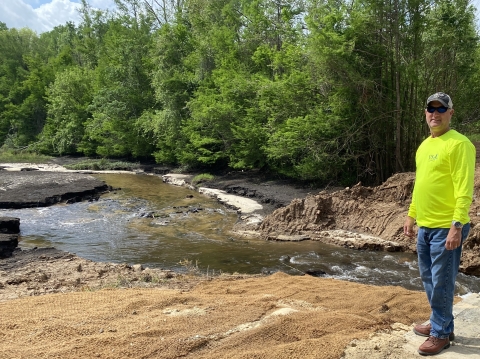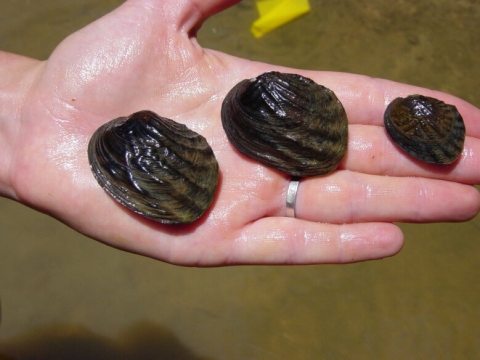Marianna, Florida – Finally, some good news for the Apalachicola River.
After centuries of pollution, drought, sprawl, dredging, straightening, dam-building, and a “water war” between Florida, Georgia, and Alabama, the iconic river whose headwaters reach into the Appalachian Mountains has something to brag about.
Seems the most vulnerable of its riverine residents, the freshwater mussels, are making a comeback. Scientists say the federally endangered fat threeridge, for example, “is far more abundant and widely distributed … than previously thought.” The same can be said for the Chipola slabshell, a threatened mollusk that lives along a major Apalachicola tributary with headwaters in Alabama.
The U.S. Fish and Wildlife Service now proposes to remove the two mussels from the list of threatened and endangered species -- the first downlisting of any species east of the Mississippi River as a result of extensive recovery and restoration efforts.
It’s a far cry from 1981 when a biologist certified the last living fat threeridge in a major Apalachicola tributary.
So, what happened?
The end of dredging along the Apalachicola surely helped, as did the absence of any killer droughts the last decade. Many state, federal, and nonprofit partners have done great work improving stream-hugging habitats across the Apalachicola, Chattahoochee, Chipola, and Flint rivers. And the search for mussels intensified the last 15 years.
But maybe the answer was there all along. Maybe the mollusks never disappeared in the first place. And maybe we just didn’t know it.
“We have definitely asked that question,” said Sandy Pursifull, a freshwater ecologist with the U.S. Fish and Wildlife Service. “Without a doubt there have been more surveys in the last two decades. And a lot of my colleagues think that the river has stabilized since dredging stopped and something caused the mussels to come back in the last 20 years or so.”
Whatever the reason, the recovery of the at-risk species is a success story worth celebrating, especially on the heels of the 50th anniversary of the landmark Endangered Species Act.
It is also a much-needed win for the Apalachicola-Chattahoochee-Flint river basin which, for decades, has dealt with hydrologic, economic, and political machinations beyond its control.
“The river is improving,” said Dan Tonsmeire, the Apalachicola Riverkeeper emeritus who knows the Apalachicola, stem to stern, as well as anybody. “We’ve had good water flows since the droughts left us alone and steady water is the key no matter what anybody tells you. It’s reshaping the river, the banks, the sloughs, and all that. It’s getting healthier.”
The river’s unsung heroes
A decade ago, the Chipola River was under siege with more than 1,200 “potential threats” to its health, as well as the wellbeing of its most troubled mussels. Chris Metcalf, who coordinates the federal-landowner Partners for Fish and Wildlife Program for the Service across the Florida Panhandle, set about tackling the water-quality problems that stretched from river’s edge to tributary headspring.
Baggett Farms along a bend in the river was Metcalf’s first Chipola project a decade ago. Not too long ago, he crossed three pastures and pulled up alongside the river as a lone bull eyed his every move. The Baggetts grow peanuts, cotton, oats, and cattle on more than 5,000 acres. It’s the cows, though, that attracted Metcalf. They used to wallow in the river, doing their business, eroding the banks, and kicking up mussel-killing sediment. Working with farmers, Metcalf laid five miles of cattle-exclusion fencing along the river and tributaries, rebuilt the riverbank with logs, trees, and shrubs, and installed a culvert, three low-water crossings, and three solar-powered wells.
“Cows used to be all down in here, in the creek,” Metcalf said alongside a riparian riparian
Definition of riparian habitat or riparian areas.
Learn more about riparian row of cypress, black gum, willow, and river birch he planted. “The bluff was vertical, just a straight up-and-down cliff. Now, you get out there and float the river and you can never tell what it used to look like. The river, as a whole, is pretty intact due to all the projects we’ve done over the years.”
Metcalf, joined by the Florida Fish and Wildlife Conservation Commission, the U.S. Department of Agriculture, the Apalachicola Riverkeeper, and others, has worked on 20 projects on five private properties across the Chipola River watershed. They’ve protected 74 acres of stream-side habitat, planted 4,000 trees, installed 16 miles of cattle fencing, and restored 10 miles of stream buffers.
“All that work has helped to increase the population of mussels and created more habitat for them to thrive and survive,” Metcalf said.
Freshwater mussels are the unsung heroes of river life. They suck up water to feed and, in the process, filter out bacteria, pollutants, and sediment. The “livers of the river” also serve as keystone species, indicators of a river’s health, and the quality of its water. When they’re in trouble, we’re in trouble. And, boy, are they in trouble.
They’re considered the most imperiled group of animals in the United States. And the Southeast is home to more freshwater mussels than anywhere else in the world. Georgia, alone, tallies 120 varieties. Three-dozen species have already been lost to extinction. In 2022, the Service proposed listing three Tennessee mussels as endangered. The southern elktoe mussel, native to the Apalachicola basin, was also recommended for listing. The Service later declared eight southern mussel species extinct.
The basin is chock full o’ mollusks with colorful names and critical jobs. Of 32 species, six are listed as threatened or endangered. It’s a wonder that only a couple of species have gone extinct, though, given threats across the nearly 20,000-square-mile basin. The Chattahoochee River, for example, tallies 13 impoundments, or dams. The Flint River has three.
Freshwater mussels prefer a steady stream of well-oxygenated, clean water. Dams – considered a mollusk's mortal enemy – not only interrupt the flow of water and sediment, but impact temperatures too. And the larger dams keep mussel larvae, which hitch rides upstream on fish, from reaching new turf.
From top to bottom, the entire Apalachicola basin runs roughly 500 miles mostly through cropland where sedimentation, chemicals, and fertilizers leach from fields and forests into rivers. Atlanta, Columbus, Albany, and other towns accidentally spill sewage, or let sediment flow, into the rivers. Adult mussels are sedentary creatures that burrow into the shallow, sandy bottoms without the ability to move if habitats are polluted or disturbed.
And disturbed they were every few years when the river was dredged to keep it navigable. The barges plopped muck onto the banks creating “sand plugs” that block creeks and sloughs.
The low flow of the river, though, is the Apalachicola’s “most significant cause of habitat loss,” according to the Riverkeeper. Periodic droughts have long hammered the river and its denizens, but conditions “changed from chronic to crisis” during the killer drought of 2011-2012. The Flint hit historic low-water levels. The agricultural industry in nearly all Georgia counties was ruled a federal disaster. Oystering in Apalachicola Bay, dependent upon a healthy mix of fresh and salt water, went belly up.
Washington, D.C declared the bay a fishery disaster in 2013 and, the next day, Florida’s governor announced he was suing Georgia for hogging the river water. It was just the latest salvo in the 30-year “water war” between Florida, Georgia, and Alabama over who gets how much of the three rivers. Georgia, which withdrew 82 percent of the basin’s water, argued that Atlanta and its economy would shrivel with less water. Alabama demanded more for its towns, farms, and development. And Florida insisted that its oysters, sturgeon, and mussels were disappearing.
'A bit of a surprise’
Sweetwater Creek was flowing fast and brown, filled with decades of built-up organic matter destined to nurture the Apalachicola River a half-mile away. Many miles of stream once meandered behind the earthen dam. But the dam severed the creek from the river’s floodplain and, consequently, kept the mussel-toting fish from swimming upstream.
Metcalf and partners had recently breached 1,500 feet of levee allowing the fish free passage upstream. They took out the dam and put in a bridge so the landowners can reach the rest of their ecologically rich bluff-and-ravine property.
“We're letting it, naturally, carve out a channel,” Metcalf said, a backhoe putting the finishing touches on the embankment. “This will benefit the fat threeridges, the shinyrayed pocketbooks, the oval pigtoes, the purple bankclimbers, and more. Their fish hosts will be able to swim up 30 miles of the creek and drop off the glochidia (mussel larvae) and repopulate these areas.”
It would’ve all been for naught if the Apalachicola was still being dredged. But the Army Corps, at the insistence of Florida and environmental groups, ceased dredging in 2002. Low water flows, though, continued to bedevil the river and its critters.
In 2007, in the midst of another wicked drought, 20,000 dead fat threeridge mussels were tallied near Wewahitchka. The low water levels, though, weren’t all bad news.
“To see that many dead fat threethridges was a bit of a surprise because as far as we knew they were pretty rare,” said Pursifull whose first Service job was to count deceased mussels on the Apalachicola River. “But there were a lot of them there.”
Pursifull and colleagues’ work helped determine how much water the Army Corps would send downstream from the Jim Woodruff Dam atop the Apalachicola. In 2008, Fish and Wildlife released a biological opinion which stated the Corps’ reduced water flows, during times of drought, wouldn’t "appreciably reduce the likelihood that the four listed species” -- fat threeridge, Chipola slabshell, purple bankclimber, and Gulf sturgeon -- “can survive nor would it preclude their future recovery."
Mussel data, though, was lacking. In the early 1990s, for example, the Service surveyed the basin and collected only 32 fat threeridges. Fifteen years later, biologists took a more critical look at the three rivers and our “knowledge base … substantially increased,” according to a recovery plan for the mussel. They deployed hydraulic dredges and sieves typically used to scour streams for gold. By 2011, they’d sampled 40 sites along the Apalachicola and 10 along the Chipola and estimated threeridge abundance at 750,000 mussels.
“There’s probably a lot more, especially in deeper water,” recalled Michael Gangloff, an associate biology professor at Appalachian State University who has researched mussels in the Apalachicola-Chattahoochee-Flint over two decades.
Scientists used side-scan sonar to map mussel “mesohabitats” focusing on riverbanks and away from the previously dredged middle sections of rivers. And divers in scuba gear descended as deep as 25 feet in search of fat threeridges.
‘Well into the forseeable future’
The work paid off. Gangloff and Adam Kaeser, a Service biologist, reported in the December 2019 Journal of Fish and Wildlife Management a “robust population of approximately 9 million” threeridges. Most were found in the lower and middle reaches of the Apalachicola along the river’s edges.
“These results conclusively demonstrate that fat threeridge is far more abundant and widely distributed among mesohabitats than previously thought,” the authors wrote.
As for the Chipola slabshell, according to another recovery plan, “We expect the species to persist well into the foreseeable future.”
Biologists, though, still wonder why the mussels rebounded so nicely.
“An intriguing and important question arises,” Kaeser and Gangloff asked. “If the abundance of fat threeridge has indeed increased since the early 1990s, why has this occurred?”
Why, indeed?
The end of dredging surely protected mussels. No serious droughts, and better managed water flows, helped restore habitats. And the restoration of streambanks and tributaries feeding the Apalachicola, Chipola, and Flint rivers undoubtedly boosted water quality and mussel survival.
“The habitat, the river’s flow, everything is getting back to where the animals can survive in it better,” said Tonsmeire, the Apalachicola Riverkeeper from 2004-2018. “It just feels like it's coming back into shape again. I just wish I could live another 200, 300 years to get it back to what it was.”






